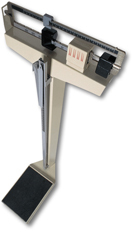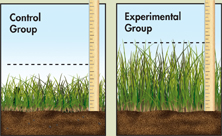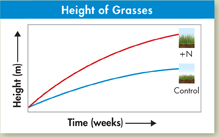Collecting and Analyzing Data Scientists make detailed records of experimental observations, gathering information called data. There are two main types of data. Quantitative data are numbers obtained by counting or measuring. In the marsh grass experiment, quantitative data could include the number of plants per plot, the length, width, and weight of each blade of grass, and so on. Qualitative data are descriptive and involve characteristics that cannot usually be counted. Qualitative data in the marsh grass experiment might include notes about foreign objects in the sample plots or information on whether the grass was growing upright or sideways.
▸ Research Tools Scientists choose appropriate tools for collecting and analyzing data. The tools may range from simple devices such as metersticks and calculators to sophisticated equipment such as machines that measure nitrogen content in plants and soil. Charts and graphs are also tools that help scientists organize their data. In the past, data were recorded by hand, often in notebooks or personal journals. Today, researchers typically enter data into computers, which make organizing and analyzing data easier. Many kinds of data are now gathered directly by computer-controlled equipment.
▸ Sources of Error Researchers must be careful to avoid errors in data collection and analysis. Tools used to measure the size and weight of marsh grasses, for example, have limited accuracy. Data analysis and sample size must be chosen carefully. In medical studies, for example, both experimental and control groups should be quite large. Why? Because there is always variation among individuals in control and experimental groups. The larger the sample size, the more reliably researchers can analyze that variation and evaluate the differences between experimental and control groups.
MYSTERY CLUE 
Describe a controlled experiment that can be designed to test the hypothesis that extra HGH helps children grow taller. What ethical issues can you imagine in actually carrying out such a study?
Figure 1–3 Continued
COLLECTING AND ANALYZING DATA
The researchers sampled all the plots throughout the growing season. They measured growth rates and plant sizes, and analyzed the chemical composition of living leaves.
DRAWING CONCLUSIONS
Data from all plots were compared and evaluated by statistical tests. Data analysis confirmed that marsh grasses in experimental plots with additional nitrogen did, in fact, grow taller and larger than controls. The hypothesis and its predictions were supported.
Table of Contents
- Formulas and Equations
- Applying Formulas and Equations
- Mean, Median, and Mode
- Estimation
- Using Measurements in Calculations
- Effects of Measurement Errors
- Accuracy
- Precision
- Comparing Accuracy and Precision
- Significant Figures
- Calculating With Significant Figures
- Scientific Notation
- Calculating With Scientific Notation
- Dimensional Analysis
- Applying Dimensional Analysis






